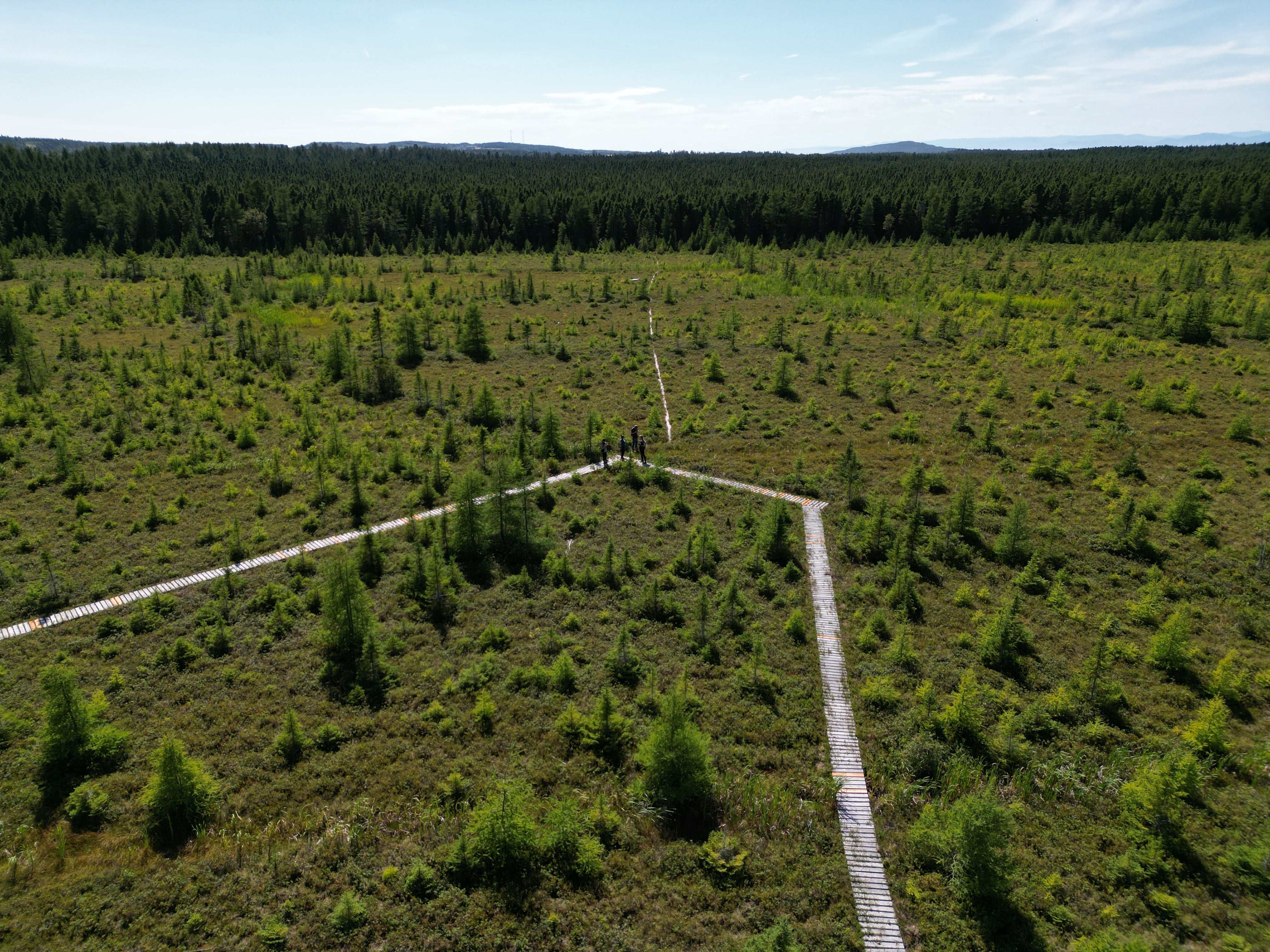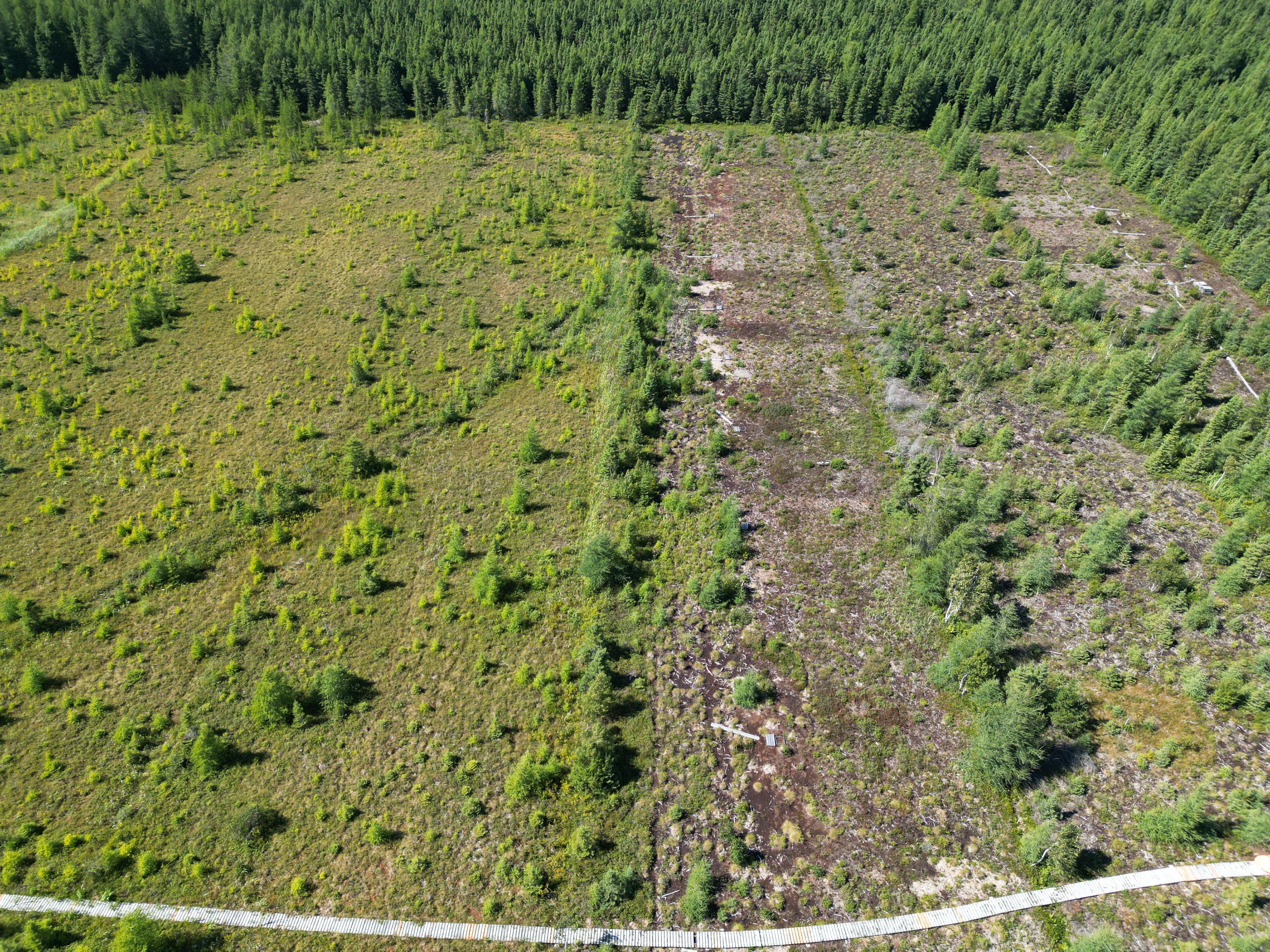By Melanie Bird
Human activities, like resource extraction, inevitably overlap with peatland areas. While only an estimated 2% of Canadian peatlands have been disturbed to date, ongoing human development will continue to impact new areas. These industrial activities disrupt the natural ability of peatlands to sequester atmospheric carbon dioxide (CO2) and store it as soil carbon. Depending on the disturbance type and how it changes the normal conditions present in that peatland, impacted areas may also release previously stored soil carbon as CO2 or methane (CH4). These changes to the usual greenhouse gas (GHG) exchange have significant global implications for climate regulation, so ecological restoration or reclamation is necessary for disturbed areas to regain their normal GHG functions.
Restoring GHG Exchange Rates in Disturbed Peatlands
Restoration/reclamation trials originating on former horticultural peat extraction sites have repeatedly demonstrated that rewetting and revegetating the site with peatland species can return a self-sustaining peatland plant community. These trials have culminated in recommended best management practices that utilize the moss layer transfer technique (MLTT) to introduce a multi-layered plant community of diverse mosses and vascular species. New trials for other disturbance types like oil and gas mineral well pads are also demonstrating success using similar methods. However, few restoration/reclamation trials have measured the GHG exchange response due to the labour-intensive nature of field GHG measurements. The results of the available studies provide a mixed picture because of the many interactions between peatland setting, disturbance type, restoration strategy, and the different study designs. There is also a lag period after groundwork and revegetation activities are applied that needs to be accounted for as the plant community re-establishes.
Many questions remain, such as: How well do restoration/reclamation activities as a whole return the normal GHG exchange rates to disturbed peatlands? Is the MLTT still the best revegetation technique from a GHG perspective? And when can we expect restored/reclaimed sites to once again be net carbon sinks?
Integrating Restored GHG Exchange Data at the National Level
This project is synthesizing historical and newly collected GHG exchange data from restoration and reclamation trials across Canada to answer these questions. We are evaluating the GHG response of different restoration strategies across different disturbance types compared to unrestored/disturbed conditions and adjacent natural/undisturbed areas. We are also looking for further insight into the environmental conditions driving the greatest net carbon uptake so that restoration plans can target those specific conditions.
Data analysis is currently underway, separated by disturbance type. Early CO2 findings for trials conducted on restoration trials on horticulturally extracted peatlands are as follows:
- At the treatment level, sites receiving active restoration activities (rewetting + any kind of revegetation strategy – spontaneous regeneration, vascular species planting, MLTT) do have their net CO2sink function returned, with understory CO2 uptake slightly greater than corresponding natural plots.
- Application of restoration activities, however, does not necessarily equate to restored conditions, as plots with too low or too high water tables and persisting low plant cover continue to be net sources of CO2 even after restoration activities.
- Plots without active restoration can also be CO2 sinks, if the seasonal water table is close to the surface and enough plants spontaneously colonize. But examples of this in unrestored areas are rare.
- Regardless of the type of restoration activities applied, plots with average seasonal water tables within 25 cm of the surface and total plant covers exceeding 100% from the combined moss and vascular plant layers are the greatest CO2 sinks.
- However, rewetting + MLTT as a restoration/reclamation strategy has been the fastest and most consistent strategy to uniformly return optimal moisture conditions and vegetation covers to former peat extraction areas.
Application for End Users and Stakeholders
Restoration/reclamation is a management decision with regulatory and economic implications for end users beyond the academic community. As Can-Peat’s goal is to reduce uncertainty in GHG emission reductions resulting from management actions and contribute to policy instruments that support the implementation of those actions, adapting our scientific results into stakeholder-relevant tools is paramount. For this project, four items will be produced:
- The final compiled dataset. This will be available to download through the Can-Peat metadata repository. As the largest compilation of chamber-based GHG exchange measurements from restoration trials across Canada to date, it will be useful to other scientists, such as land use and peatland ecosystem modelers wanting to account for restored peatlands’ GHG emissions.
- A reference table of values summarizing average CO2and CH4 exchange values by restoration strategy, microform, and stage of vegetation recovery. These values can then be scaled by an end user spatially based on site conditions present to estimate the current GHG emissions at a restored site.
- Emission reduction factors that quantify the potential reductions in GHG emissions in restored areas compared to unrestored/disturbed areas. These factors will represent the current state of knowledge and will need to be updated as future trials add new data.
- A way to estimate when a site has become a net carbon sink based on easier to measure proxy variables instead of direct GHG measurements. This will be instrumental for restoration assessments as the scientific results show that the application of restoration activities does not necessarily correspond to restored status if the appropriate peatland conditions have not been reinstated, nor does a specific timeframe post restoration activities correspond to consistent GHG exchange rates.
Based on the scientific results, this final tool will be a combination of thresholds to be met for the average seasonal water table (somewhere close to the surface) and total plant cover (something over 100%). This is positive for end users, as it will allow them to assume the site has regained its carbon sink function once these conditions are met, instead of waiting for a certain timeframe to pass. The sooner these conditions are achieved, the sooner the carbon sink function will be restored. This also supports the use of the moss layer transfer technique as a preferred revegetation strategy. This technique has been shown in Canada to accelerate the establishment of desirable species, provide the most predictable and spatially uniform vegetation growth, and promote diverse, multi-strata communities consisting of both moss and vascular species – key to achieving more than 100% total plant cover.
Next Steps
In addition to the data analysis underway for the CH4 response in the restored horticultural sites and future analysis of other restored disturbance types, we will be implementing an additional case study to augment the historical results.
Responding directly to feedback from our Can-Peat stakeholders at the Can-Peat annual meeting and Peatland Science Symposium, this field study for summer 2025 will be used to validate the end user tools and demonstrate their scalability in the field. We will be collecting new GHG measurements from a mature restored peatland site with different water table positions and vegetation covers and comparing them to the results predicted by the Returned Carbon Sink Function Predictor. We will also evaluate different methods to determine the plant covers and seasonal water table position at the site scale, which can be challenging for such large areas. This case study will be an example of how integrating scientific results with management and policy decision support tools can strengthen the inclusion of restored Canadian peatlands as nature-based climate solutions.

A view in 2022 of the restored area of the Bois-des-Bel peatland complex, 23 years after restoration activities were implemented. The site was rewetted, and a diverse peatland vegetation community of desirable mosses and vascular species was introduced using the moss layer transfer technique (MLTT). Greenhouse gas measurements at this site show that it has regained its net CO2 sink function. Photo credit: Peatland Ecology Research Group (PERG)

Restored peatland conditions at the Bois-des-Bel peatland complex are observed on the left; unrestored conditions are present on the right. Photo credit: Peatland Ecology Research Group (PERG)